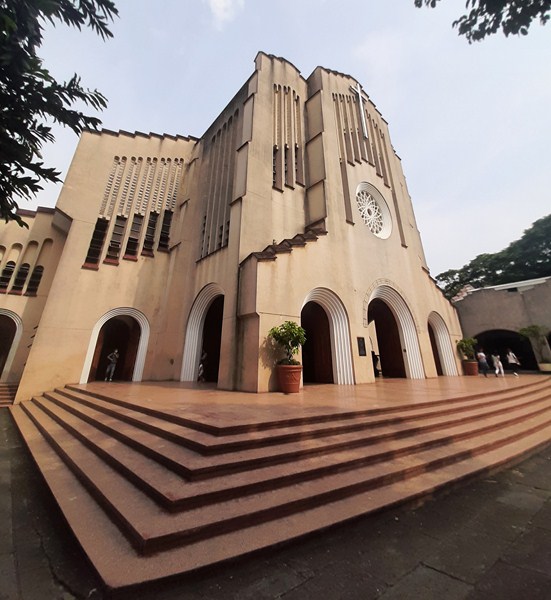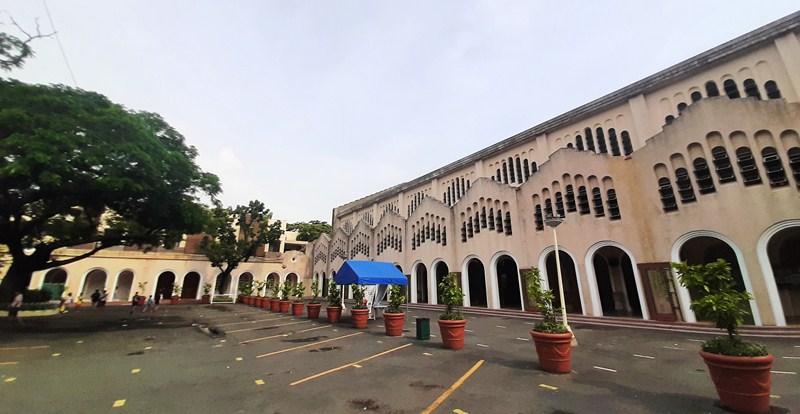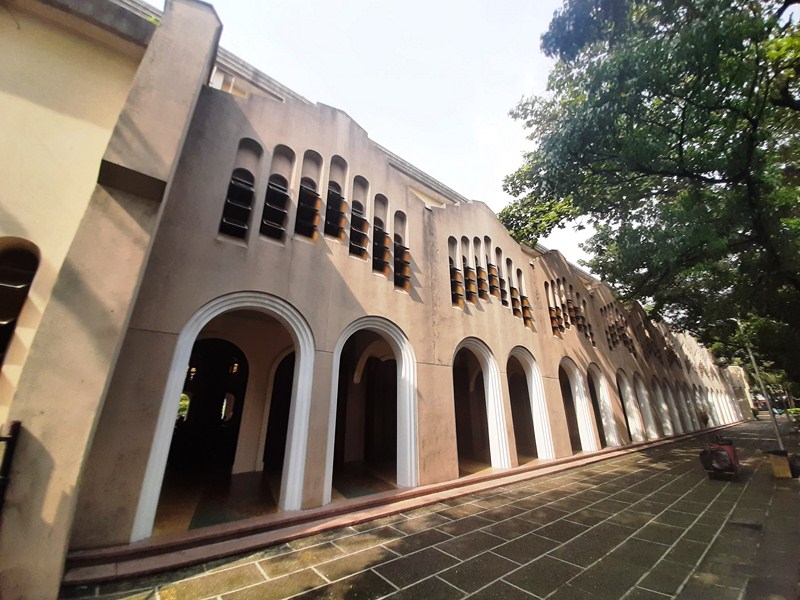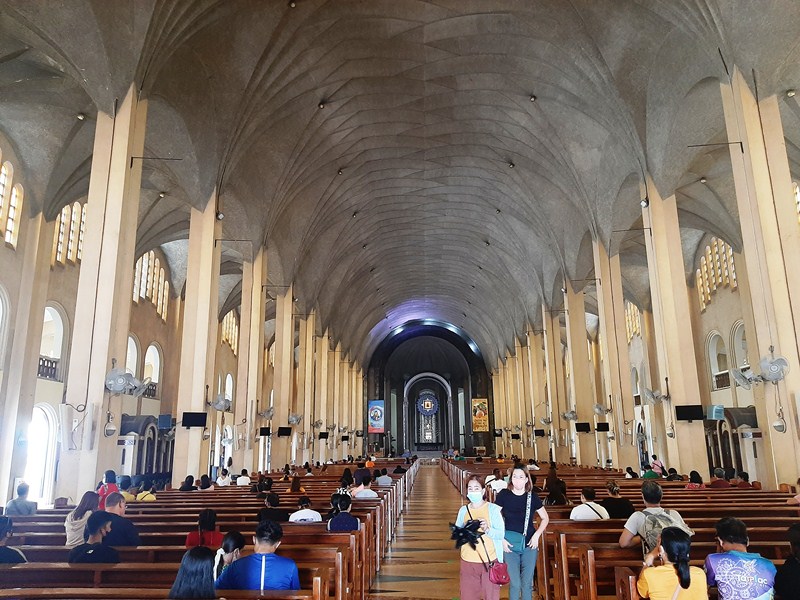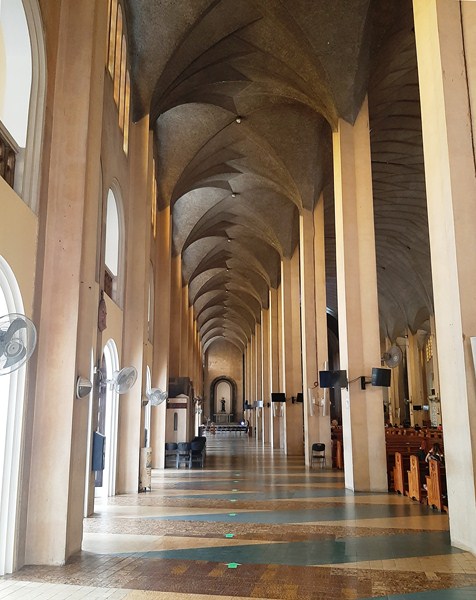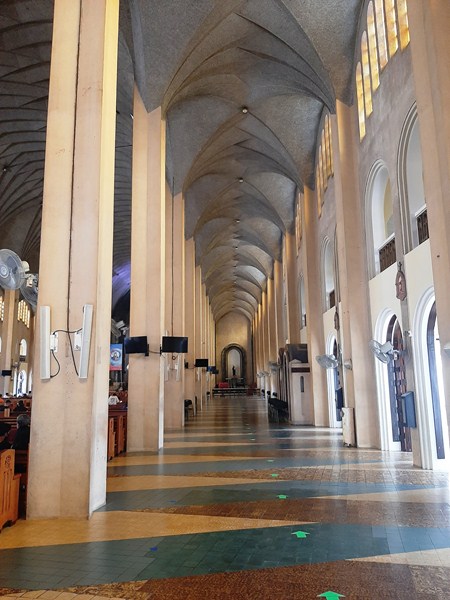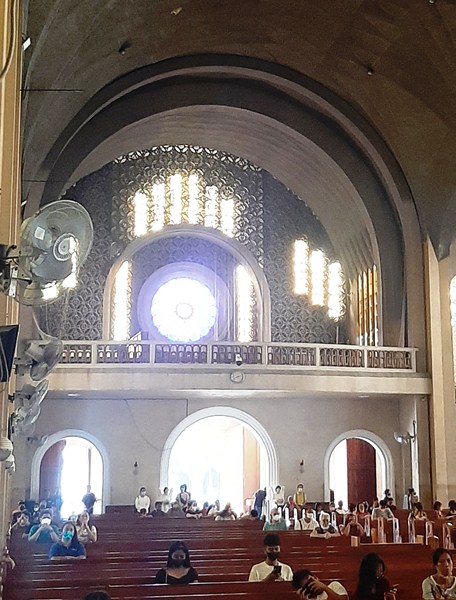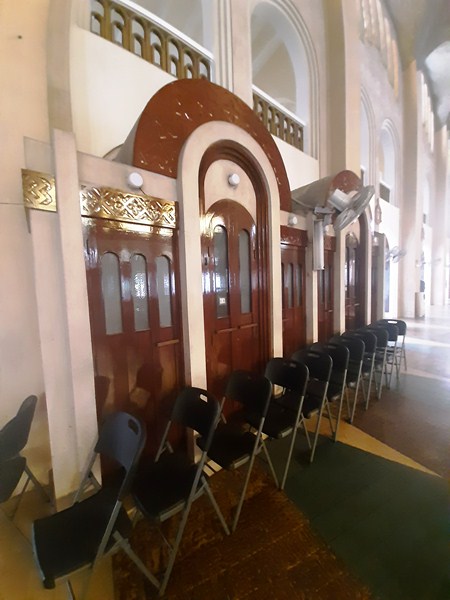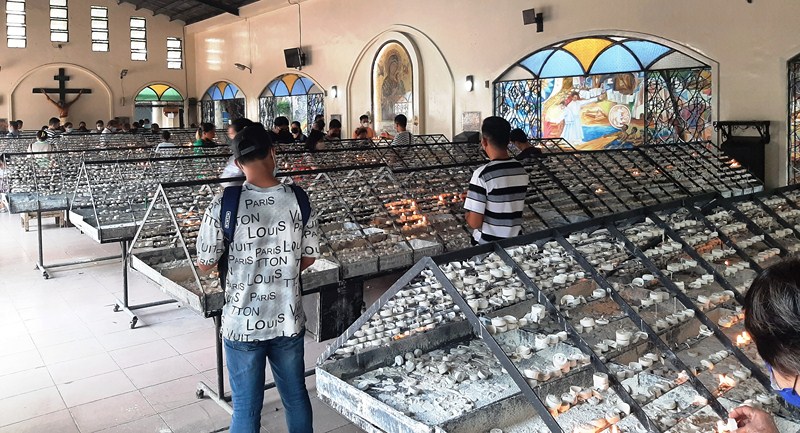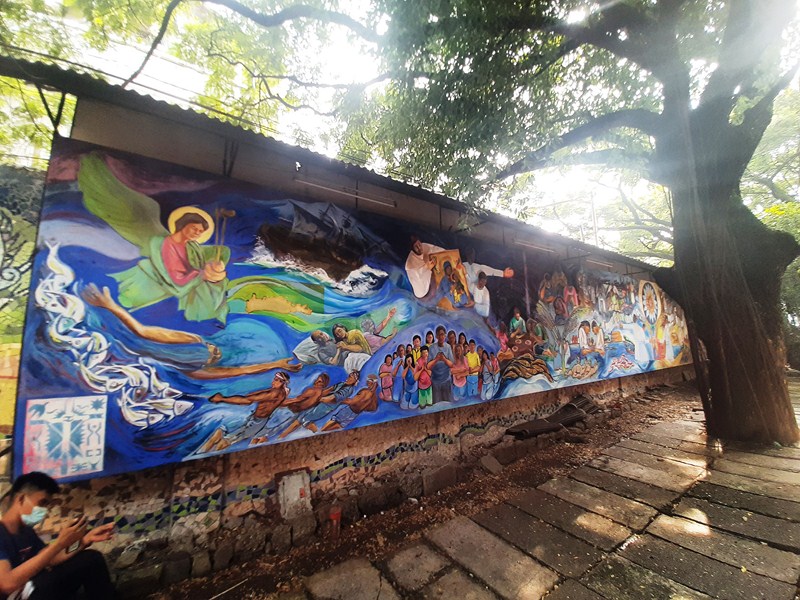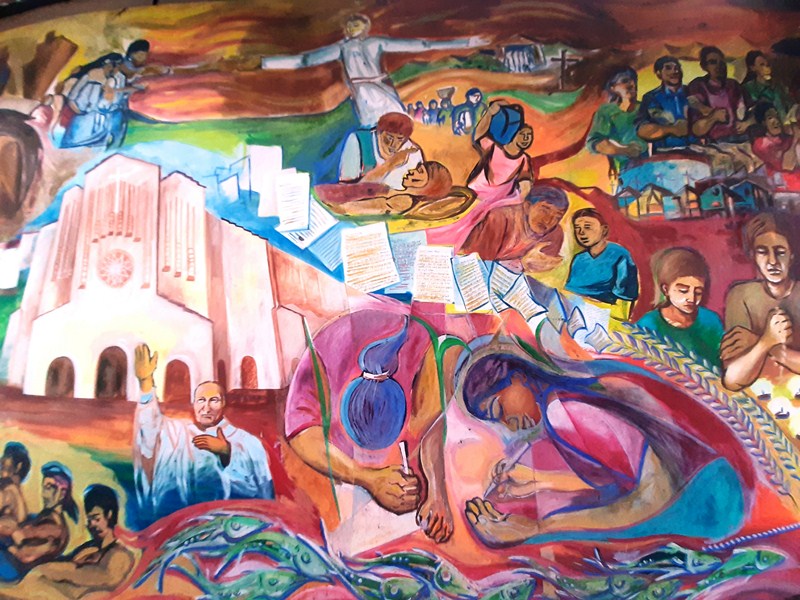The National Shrine of Our Mother of Perpetual Help (Filipino: Pambansáng Dambana ng Iná ng Laging Saklolo) , also known colloquially as the Redemptorist Church or the Baclaran Church, is a prominent national shrine dedicated to Our Lady of Perpetual Help. Enshrining the icon of Our Mother of Perpetual Help, the church is 106.7 m. (350 ft.) long, 36 m. (118 ft.) wide and stands 17.2 m. (56.5 ft.) high on the nave and 12.5 m. (41 ft.) hig on the main aisle.
It has a full seating capacity of 2,000 (9,000 to 11,000 standing) during Masses, with 108 pews seating 15 to 20 adults, and is one of the largest Marian churches in the Philippines, with a floor area of 5,069.2 sq. m. (54,564 sq. ft.).
Devotion to Our Mother of Perpetual Help is popular amongst Filipino Catholics and, during Wednesdays (popularly called “Baclaran Day” due to congested roads near the shrine),devotees flood the church to attend Mass and pray the Novena to Our Mother of Perpetual Help, introduced to Baclaran by Australian Redemptorist Rev. Fr. Gerard O’Donnell, CSsR.
Every first Wednesday of every month,liturgies and other activities are simulcast on TV Maria from the Shrine. The annual liturgical feast day of the icon is celebrated on June 27.
Here’s the historical timeline of the Redemptorist Order and the church:
- In the 1900s, Irish and Australian Redemptorists came to Manila to what was then the United States territory of the Philippine Islands.
- In 1906, the first Redemptorists came to the Philippines and set up a community at Opon, Cebu.
- In 1913, the Redemptorist community went to Malate where they built a small, popular shrine to Our Mother of Perpetual Help.
- In 1932, the community transferred to Baclaran and built a small wooden chapel.
- During the Japanese occupation of the Philippines in the Second World War, invading Imperial Japanese troops overran the church and the Australian and New Zealander priests were interred in the concentration camp at University of the Philippines – Los Baños.
- On May 6, 1946, the Novena to Our Mother of Perpetual Help was first held at the Redemptorist Church dedicated to Saint Clement Hofbauer in La Paz, Iloilo City.
- On June 23, 1948, a Wednesday, Linguist Rev. Fr. Leo J. English, C.Ss.R. conducted, with 70 participants, the first Baclaran Novena.
- In 1949, a second church was built.
- On January 11, 1953, the foundation stone of the present church was laid.
- On December 1, 1958, the new church was consecrated.
- On December 5, 1958, the church was dedicated.
- On December 8, 1958, the Feast of the Immaculate Conception, the shrine was authorized by the Holy See to remain open 24 hours a day throughout the entire year. It has been open 24 hours ever since.
- On February 1973, during a brief, unofficial stopover in Manila, Cardinal-Archbishop of Kraków Karol Jozef Wojtyła, later Pope John Paul II, said Mass in the Shrine.
- On February 17, 1981, during his first Apostolic Visit to Metro Manila, the shrine was blessed by Pope John Paul II.
- During the controversial 1986 Snap Elections, the Shrine was notably the refuge of several computer engineers from the Commission on Elections (COMELEC) when 35 technicians who were operating the COMELEC’s electronic quick count staged a walkout from their headquarters at the Philippine International Convention Center to protest alleged electoral fraud by supporters of dictator President Ferdinand Marcos.
- In 2015, a belfrywas built as part of the Shrine’s redevelopment plan.
- On September 8, 2015, the belfry was blessed by Luis Antonio Cardinal Tagle, then-Archbishop of Manila.
- On September 5, 2019, the original Icon was brought down from the altar for restoration
- On November 27, 2019, upon completion of its restoration, the icon was returned.
The Shrine, and its attached convent, were initially dedicated to Saint Thérèse of Lisieux (a grotto statue of the saint on the shrine grounds memorializes her patronage) by Rev. Fr. Denis Grogan, C.Ss.R., the builder of the new church and parish house. However, the Ynchaustí Family, long-time supporters and friends, donated a high altar on the condition that it enshrine the icon of Our Mother of Perpetual Help.
When the church opened, the shrine became very popular. To accommodate the growing number of devotees, the Redemptorist priests replaced the Our Mother of Perpetual Help icon with a larger version. An estimated 120,000 devotees are currently affiliated with the Shrine.
The wider Baclaran shrine complex, under the territory of Santa Rita de Cascia Parish (both are part of the Vicariate of Santa Rita de Cascia in the Diocese of Parañaque), located a few blocks away from the Redemptorist Church, serves as the headquarters of the Manila Vice Province of Congregation of the Most Holy Redeemer, while the Cebu Province of the Redemptorists is headquartered in Cebu.
The original icon, from Germany, was brought into the country in 1906 and is enshrined above the main altar. During the Second World War, the icon was removed from the church and given to a family for safekeeping but, towards the end of the Japanese occupation of the Philippines, their home was later burned and ransacked. Initially thought to be lost, the icon was found by a De La Salle brother among other valuable objects that the Japanese had seized and abandoned at the Old Bilibid prison. At its back paneling, it bears the Papal Arms. Though there is no access to the icon at the top of the retablo, people touch the tabernacle instead.
The present church, the third to be built on the same site, was designed in the Modern Romanesque style by architect César Concio, Sr.. It took six years to build. Most of the money came from small donations (the suggestion from the pulpit was 10 Philippine centavos per week) and this often ran out, requiring construction to stop. For a big space, the church has a light design, with good natural acoustics.
The elevated sanctuary is separated from the nave by a communion rail. The marble high altar was brought in from Italy. The baldachin, the beautiful covering of the icon above the altar, has columns and capital made of giallo oro and Bottecino marble. The gracefully carving altar rails are made of white Carrara marble.
The beautiful retable (retablo in Spanish), the large altarpiece behind the altar, incorporates the tabernacle and serves as the backdrop of the icon. It contains bronze sculptures of eight pairs of wheat stalks intertwining with each other, with their point of intersection being the tabernacle and the crucifix (surrounded by four doves representing the Holy Spirit). Floating above it is a bronze sculpture of vine and fruit grapes. The wheat and grapes, emblematic of abundance of God’s grace, symbolize the bread while wine symbolizes the Eucharist.
Located at a once drab southern wall at the back of Candle Chapel is the mixed art (mosaic, sculture and painting) mural entitled Panagpo, the longest mural in a church in the Philippines. Created in 10 months by visual artist Emil Yap and lead sculptor Lorena Pacampara in 2016, in celebration of the 150th Jubilee of the icon, it was blessed on December 2017. The mural is about the journey of the icon of Our Mother of Perpetual Help from the island of Crete to Baclaran. It is 3 m. (10 ft. high) and 213 m. (700 m.) long and has two main sections.
The first, telling the history of the country, from the pre-Hispanic Era, Spanish Colonization Era to the contemporary years, is based on the Canticle of the Sun (written by St. Francis of Assisi). The second, Sister Moon, depicts the lives pf the “untold, silenced and marginalized sectors. At the foot of the mural are the country’s flora and fauna, its names written in baybayin, the ancient, pre-Hispanic dialect.
From a blue and green scheme (representing the myth of creation and the colonization years, the panels turn red and orange as it moves further down the country’s history.
The belfry, built closer to Roxas Boulevard some distance from the Shrine itself, has mosaics of the icon on its four faces and is topped by a finial in the shape of a simplified Redemptorist coat-of-arms, particularly the Cross, Spear, and sponge on a stick of hyssop. It houses a 24-bell carillon cast from the world-famous foundry Grassmayr in Austria.
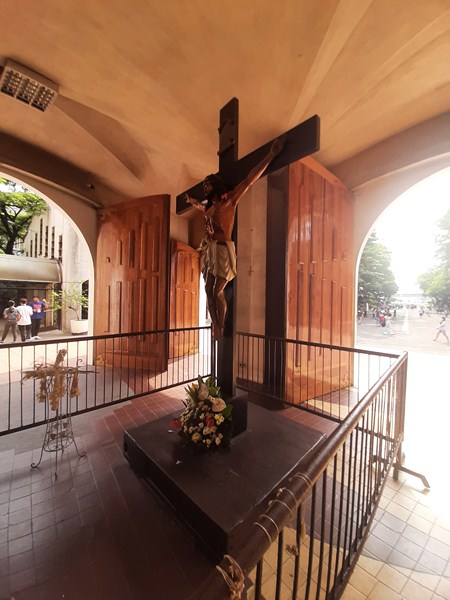
The Crucified Christ. Last December 9, 2017 (the eve of Human Rights Day), a cardboard message (“Stop the Killings”) temporarily replaced the INRI inscription on top of the cross
It was the first time the Shrine had a bell tower since it was built. The carillon bells are automatically programmed to ring 15 minutes before every Mass or Novena service. Until the COVID-19 Pandemic, the belfry hosted the Sinirangan coffee shop at its base. Today, it is located at the Perpetual Help Center and Souvenir Shop.
The church appeared in the opening scene for the 1979 dramatic film “Ina Ka ng Anak Mo” (starring Nora Aunor); the 1995 action film “Alfredo Lim: Batas ng Maynila” (starring Eddie Garcia); and in the opening scene for the 2017 romantic comedy film Loving in Tandem. The church’s votive chapel as well as the altar also makes an appearance in the romantic 2015 film You’re Still The One. In 2014, the church was also featured in the American reality competition program The Amazing Race Season 25
National Shrine of Our Mother of Perpetual Help: Redemptorist Rd. cor, Roxas Boulevard, Baclaran, Parañaque,1700 Metro Manila. Tel: (632) 8832-1150. E-mail: baclaranrector@yahoo.com. Website:
www.baclaranchurch.com. Coordinates: 14.531411°N 120.9930539°E.

